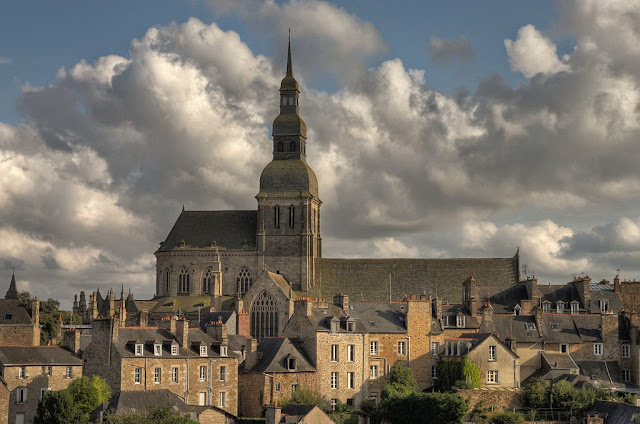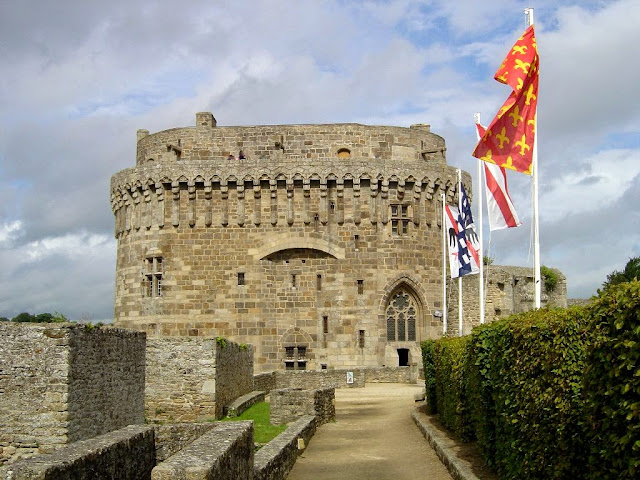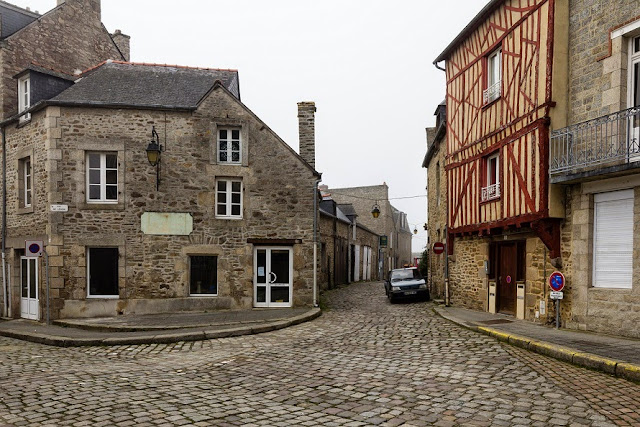Dinan is a French commune, sub-prefecture located in the department of Côtes d'Armor in Brittany. It is a city of Poudouvre (didn't find Wikipedia info in english) in Upper Brittany.
The city is fortified by a belt of walls and was defended in the past by an imposing castle. It was a strategic point for traffic between Normandy and the north coast of Brittany. It is located on a hill. Being there it is possible to see up to 75 meters of the Rance River, which flows north and empties into the English Channel (La Manche), between Saint-Malo and Dinard. Have a look to the picture above. But not only for its spectacular view over the river it was considered a strategic point. Dinan is also the axis point of the community of communes of Dinan.
Dinan area was inhabited since the Neolithic, as suggesting the presence of a dolmen in ruins just outside the town towards Lanvallay.

The written or graphic history of Dinan is known from the eleventh century since it was the time in which a Benedictine convent was implanted in the village. One of the fragments of the Bayeux Tapestry evokes the destruction by William the Conqueror of a motte-and-bailey castle in this area.
Organized around the parishes of Saint-Malo and Saint-Sauveur, half of Dinan was purchased in 1283 by the Duke of Brittany Jean le Roux. It was at this time that the city acquired the belt of walls we know actually. The towers of Beaumanoir, Vaucouleurs, Saint-Julien, Beaufort, Connétable, Coëtquen, Penthièvre, Longue and Sainte-Catherine surrounding the old city counterclockwise. This ride is still intact on 2600 meters spanning across the doors of Arvor, Saint-Malo, Brest, Guichet and finally Saint-Louis. A marvelous trip to the middle Ages well away from the filthy smoke of large cities.
Sainte-Catherine |
Beaumanoir (inside) |
|---|
In 1357 during the war of succession of the Duchy of Brittany, Bertrand Du Guesclin and his brother Olivier successfully defend the besieged city by British troops and Britons faithful to the Duke Jean de Montfort. Finally in 1364 the Duke takes control of the city and built the dungeon known as the Duchess Anne. The fortifications of the city was modernized with the addition of many artillery towers. In 1488 the governor defeats the keys of the city to the representative of the King of France after the Battle of Saint-Aubin du Cormier. Like all other Brittany villages, Dinan is finally annexed to the Kingdom of France in August 1532.
Dungeon of the Duchess Anne as can be enjoyed actually
|
|---|
The town thrives on strong domestic business activity and the presence of a port on the Rance river that favoring trade. Dinan controls waterway freight to the north. This economic prosperity and peace, blessed be the peace, makes that fortifications and defenses of the Middle Ages were abandoned and no longer maintained. In the seventeenth century religious orders which promote peace and trade are installed. Dinan is quoted by a revolt occurred in 1675 known as the Revolt of the papier timbré. The religious aspect is handled from the Abbaye Notre-Dame du Tronchet (sorry, no english info). I'm impressed how French retain their heritage. Very important. As my dear uncle Simon said: if we know what we were and what we are we will know better where we're going.
Abbaye Notre-Dame du Tronchet as is actually_Abbatiale_Notre-Dame_1.jpg) |
|---|
During the eighteenth century commercial activity is stimulated by the installation of many weavers who produce fabrics and paints used for the sails of boats that are sent to Saint-Malo through the Rance Valley. Powered by a bourgeoisie that develops, so bad that is talk about the bourgeoisie and how much it contributes to the development of civilization, various measures to combat unhealthy prevailing in the city are taken. Dinan was experiencing a strong extramural commercial development. During episodes of the second Paris Commune, Dinan joined this political model and the Municipality of Dinan, which officially still exists was created.
Riverside (on Rance river) of Dinan. Photo by Toshioohsako |
|---|
In the nineteenth century the port gradually lost its importance with the construction in 1852 of an overpass over the highway leading into the city and with the arrival of the railroad in 1879. With prosperity many opulent mansions were built and little by little Dinan became a particularly popular tourist destination among Britons. It was the scene of bloody battles between Germans and Americans during the II World War and part of historical heritage was destroyed. With the same force that I bless peace I curse war. Again with the arrival of peace the city restored much of its heritage. Half-timbered houses still align la Place des Cordeliers, la rue de l'Horloge, the famous rue du Jerzual and other paved roads. The churches of Saint-Sauveur and Saint-Malo rise amid the ancient parishes of the town. Dinan today overflows its ancient fortified walls and extends to the municipalities of Léhon, Quévert, Taden and Lanvallay. Peace and prosperity triumphed over war and decay.
Church of Saint-Malo at Dinan |
|---|
Well, time to go. Being in Paris the best way to go to Dinan is via the train #TGA8081 that leaves from Gare Paris Montparnasse (17, Boulevard de Vaugirard, Paris 15, Metro Lines 4, 6, 12 and 13) at 7:42, M, Tu, W, Th and F. This train arrives to Dol-de-Bretagne at 10:37. Change to the train #TER54115 that leaves Dol-de-Bretagne at 10:42 and arrives to Dinan at 11:05. Total journey time with changes is about 3 hrs 23 mins. Su and Sa, there is the train #TGA8091 that leaves from Gare Paris Montparnasse at 8:12 arriving to Dol-de-Bretagne at 11:06. Change to the train #TER54121 that leaves Dol-de-Bretagne at 11:15 and arrives to Dinan at 11:38.
Well, we are already here. You should have booked your accommodation in advance. It's very important and never I will be tired to insist on this. All France as a tourist country is very requested and hotels are the most. Here at Hotels.com you will find many options in Dinan. Select what you like. You can also have a look to Trip Advisor that always has very good recommendations. Here you have: Hotels, B&B, Vacation Rentals, Vacation Packages, a Dinan map and a Travel Guide. It's a must to visit the Tourist Office. They always will have the most trusted and updated info about Dinan.
There are a lot of places to visit. The Eglise Saint-Malo (church Saint-Malo) which its building is a typical and fine example of Flemish Gothic art. The choir built in 1491 is surrounded by eight naked pillars forming a gallery (triforium) and holding a granite arch that rises 21 meters. See photo above. The Basilique Saint-Sauveur is a religious building affected to the Catholic Church. It is a place of devotion for Our Lady of Virtues whose representation of the Assumption of the Virgin allowed the building to be erected as a small basilica by Pope Pius XII on May 23, 1954.
Basilique Saint-Sauveur |
|---|
The Château de Dinan (Dinan Castle) is a building consisting of a tower and a door that are part of an extensive wall that still surrounds the city. John IV, Duke of Brittany, began construction of the tower in 1384, consisting of two interconnected circular towers and a moat that separate it from the surrounding defenses and the city. The castle was declared a historical monument in 1886.
Château de Dinan |
|---|
The Centre Historique (Historic Downtown). Preserving from destruction, the medieval city center of Dinan has a hundred of houses with wood sides. Its richness and quality of the layout makes them the best of Britain.
Centre Historique
|
|---|
The Tour de l'Horloge (Clock Tower) of the fifteenth century is 45 meters high, contains a bell offered to the city by the Duchesse Anne of Brittany which dates from 1507. It is open to the public and from the top you have magnificent views of the city.
Tour de l'Horloge |
|---|
The Rue du Jerzual (Jerzual Street) linking the port with the city. It's undoubtedly the most important street of the city, as once was the main access to the center of Dinan. It is a narrow road with a steep gradient. At the end of the street is Le Logis du Jerzual (Jerzual Gate), a watchtower of the thirteenth century.
La Rue du Jerzual |
|---|
The Petit Train de Dinan (Dinan Little Train) is the most pleasant way to explore the city. Explore on foot is not easy. There are important differences in height (40 meters apart) between the highest and lowest parts of the city. The train runs through the old town, the half-timbered houses, the Basilique Saint Sauveur, wherein lies the heart of Bertrand Du Guesclin, the Tour de L'Horloge, the Place Duclos and l'Hôtel de Ville, the Remparts, the Jardin Anglais (English Garden) and the Viaduc (Viaduct), impressive for its architecture 250 meters long and 40 meters high.
As I said a lot of places to visit. You could stay some days in Dilan having a great time. Far, far, far away from the stress of your city, your job, your boss of course, and all those things that make you thinking if life is only work. Here some other places we can enjoy in or close to Dinan:
- Domaine de La Bourbansais: A beautiful tour to be enjoyed by everyone. Really incredible from the castle to the zoo. I'm very sorry presentation is in French but even that way it worth to see the video completely. And going to the tour of course. Information here in english.
- Canal (Channel) d'Ille-et-Rance: a quiet greenway, flat, shaded in summer and running through a beautiful landscape dotted with flowering locks, mills and charming old buildings. What more for hiking biking or jogging? You will follow the channel from the historic center of Rennes. You will reach Dinan, then Dinard along the old railway line and finally Saint-Malo where you will board a boat. An unforgettable trip.
- Chateau de la Hunaudaye: Hunaudaye Castle is a medieval fortress built in the XIII century, situated in the French commune of Plédéliac in Côtes d'Armor, Brittany. It is classified as a historical monument of France since February 1922.
- Le Motor Boat Vedette Jaman IV: This boat will take you over the river current and also through time and history. You will tour the Rance river which finally empties into the Atlantic on green and magical landscapes. On the left bank the towpath, preferred route of old tractors of yesteryear, horses, donkeys and mules. .
Dinan
Do not miss
- Best Towns in France
- Le Puy en Velay
- Baume les Messieurs
- Cassis
- Sainte Eulalie d'Olt
- La Roque Gageac
- Sainte-Agnès
- Lyons-la-Fôret
- La Bastide Clairence
- Gordes
- Yèvre-le-Châtel
- Locronan
- Preparing your trip to Paris
- Visiting Île de la Cité
- Where to find the best France Tour
- Group Travel vs Single Travel
- How to be happy in Le Moulin Rouge
- A medieval day in Bruges
- Holiday Apartments in Europe
Ce blog est une fenêtre à travers laquelle le monde anglophone peut voir votre entreprise. Forfait à partir de 10 euros par mois, pas de clic ou impressions. Écrivez-moi si vous êtes intéressé. Ci-dessous, un formulaire de contact.
